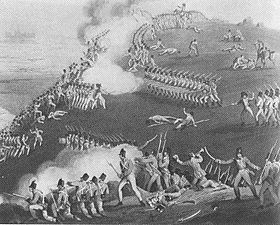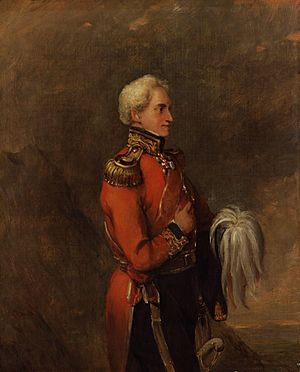Battle of Castalla facts for kids
Quick facts for kids Battle of Castalla |
|||||||
|---|---|---|---|---|---|---|---|
| Part of Peninsular War | |||||||
 Battle of Castalla |
|||||||
|
|||||||
| Belligerents | |||||||
| Commanders and leaders | |||||||
| Strength | |||||||
| 12,000 | 17,000 | ||||||
| Casualties and losses | |||||||
| 1,700 killed | Biar: 301, 2 guns Castalla:700 |
||||||
The Battle of Castalla was an important fight during the Peninsular War (part of the Napoleonic Wars). It happened on April 13, 1813, near Castalla, Spain. In this battle, an army made up of soldiers from Britain, Spain, and Sicily fought against the French army.
The Allied forces were led by Lieutenant General Sir John Murray. The French army was commanded by Marshal Louis Gabriel Suchet. Murray's troops were in a strong position on a hill and successfully stopped many French attacks. This forced Suchet's army to retreat. This victory helped the Allied side in the war.
What Happened Before?
The Peninsular War was a long conflict where France, led by Napoleon, fought against Spain, Portugal, and the United Kingdom. Marshal Suchet was one of Napoleon's best generals in Spain. He was very good at controlling the areas of Aragon and Valencia.
Marquess Wellington, the main British commander, knew that if Suchet's army joined other French forces, it would be a big problem. So, Wellington wanted to keep Suchet busy on the east coast of Spain. This would stop him from helping other French armies.
An Allied force of British, Sicilian, and Spanish soldiers had been stationed in Alicante since 1812. In February 1813, Sir John Murray took command of this army, which grew to about 18,000 soldiers.
The French Attack
In early April, Murray's army was near Villena. Marshal Suchet decided to surprise them. He split his army into two groups. One group, led by General Jean Isidore Harispe, attacked a Spanish force at Yecla. The other group, led by Suchet himself, marched towards Murray at Villena.
On April 11, 1813, Harispe's French soldiers attacked the Spanish troops at Yecla. The Spanish were caught off guard and lost many soldiers, with hundreds killed and a thousand taken prisoner.
When Murray heard about this defeat, he quickly ordered his army to retreat towards Alicante. He left a smaller group of 2,200 soldiers, led by Colonel Frederick Adam, at a mountain pass called Biar. Their job was to protect the main army's retreat.
On April 12, Suchet's army chased Murray's forces. At Biar, the French caught up with Adam's group. But Adam's soldiers, who were from Britain, Germany, Italy, and Spain, fought bravely. They held off the French for five hours. This brave defense allowed Murray's main army to get to a strong defensive spot near Castalla. During this fight, Adam's group lost some soldiers and two cannons, but they stopped the French from completely overrunning them.
The Battle at Castalla
Murray's army at Castalla had about 17,000 soldiers and 30 cannons. They were set up on a strong ridge with a castle on top. A deep stream bed was in front of them, making it hard for the French to attack. A flooded stream also protected their right side.
- The Spanish soldiers, led by Colonel Samuel Ford Whittingham, were on the left side.
- Colonel Adam's brigade was in the middle-left.
- General John Mackenzie's division was in the middle-right.
- General William Henry Clinton's division was on the far right.
- Other Spanish troops and cavalry were kept in reserve behind the castle.
Suchet's French army had about 12,000 soldiers and 24 cannons. He planned to attack the center of Murray's line. He thought the Spanish and Italian soldiers would run away easily.
At noon on April 13, the French attacked. They moved forward in several columns. However, Colonel Whittingham's Spanish soldiers stood firm and pushed back the French attacks on their side. Adam's British troops also fought fiercely in the center. In one intense fight, Adam's 2/27th Foot regiment caused heavy losses to a French regiment. The French cavalry tried to go around the Allied right side, but they couldn't cross the flooded stream.
With their attacks failing and suffering many losses, the French found themselves in a tough situation. Murray's army had successfully defended their position. Suchet decided to retreat. Murray didn't chase them immediately, so the French were able to get away with few extra losses, thanks to their rearguard defending the Biar pass again.
What Was the Result?
The Allied army lost about 440 soldiers in the battle. The French suffered much heavier losses, likely around 1,300 soldiers.
Even though Murray won the battle, he didn't follow up on his victory. Instead, he continued his retreat back to Alicante. The next major event in this area was the Siege of Tarragona. The Battle of Castalla was a clear victory for the Allied forces, showing that they could successfully defend against French attacks.


